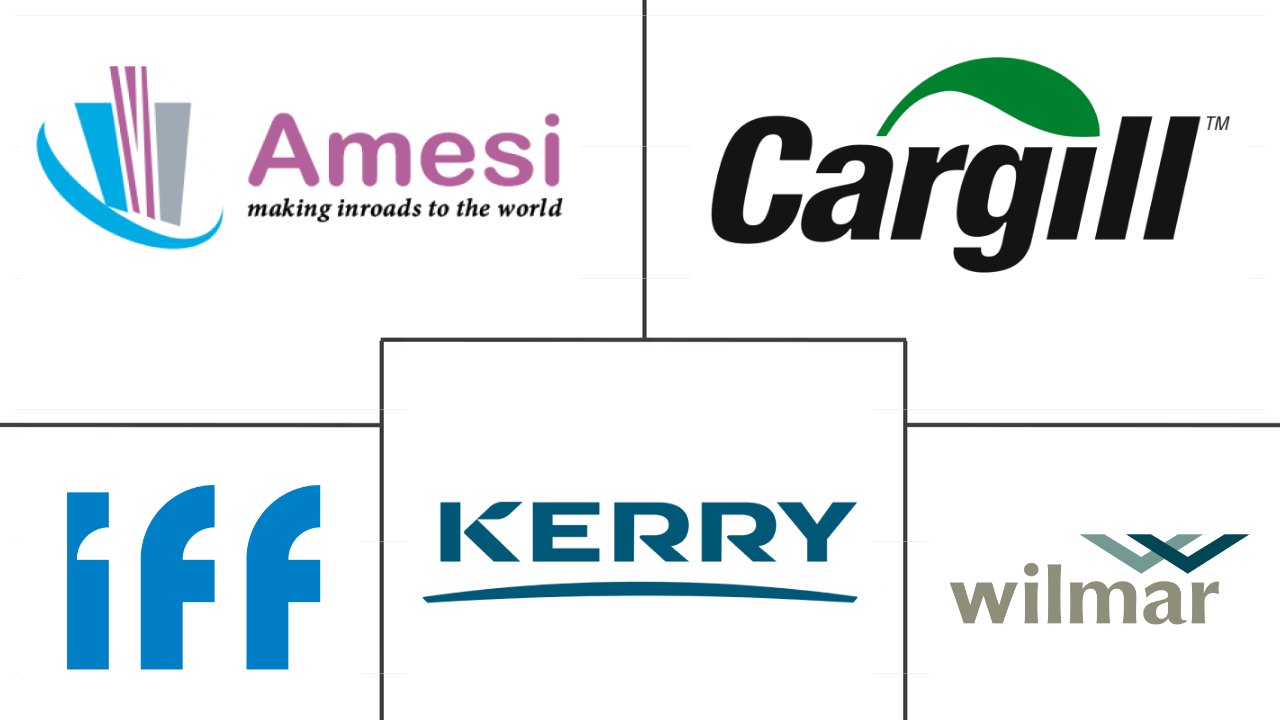Market Size of africa plant protein ingredients Industry
|
|
Study Period | 2017 - 2029 |
|
|
Market Size (2024) | USD 1.35 Billion |
|
|
Market Size (2029) | USD 1.69 Billion |
|
|
Largest Share by End User | Food and Beverages |
|
|
CAGR (2024 - 2029) | 4.58 % |
|
|
Largest Share by Country | Nigeria |
Major Players |
||

|
||
|
*Disclaimer: Major Players sorted in no particular order |
Africa Plant Protein Ingredients Market Analysis
The Africa Plant Protein Ingredients Market size is estimated at 1.35 billion USD in 2024, and is expected to reach 1.69 billion USD by 2029, growing at a CAGR of 4.58% during the forecast period (2024-2029).
1.35 Billion
Market Size in 2024 (USD)
1.69 Billion
Market Size in 2029 (USD)
4.24 %
CAGR (2017-2023)
4.58 %
CAGR (2024-2029)
Largest Market by Product Type
70.36 %
value share, Soy Protein, 2023
Soy protein remained the most favored, owing to its inexpensive cost and excellent quality. The F&B and the animal feed segments drove the soy protein type in the region.
Largest Market by End User
51.75 %
value share, Food and Beverages, 2023
The F&B segment dominates the market, primarily led by the bakery and meat and dairy alternatives sub-segments due to the functionalities of plant protein ingredients, which makes them the preferred ingredients in these industries.
Fastest Growing Market by Product Type
9.22 %
Projected CAGR, Pea Protein, 2024-2029
Pea proteins are gaining demand as meat alternatives due to their quick rehydration, neutral flavor, and texturizing abilities, which has led to a slew of new products.
Fastest Growing Market by End User
4.60 %
Projected CAGR, Supplements, 2024-2029
Rising demand for natural ingredients and protein-enriched skin, body, and hair care products is driving the segment, which is projected to record the fastest growth during the forecast period.
Leading Market Player
4.44 %
market share, International Flavors & Fragrances Inc., 2021

The company has prioritized innovation as a growth strategy to strengthen its market position further and focuses on current trends, such as healthy snacking.
F&B sector dominates due to strong demand for plant proteins from bakery products across the region
- The F&B segment drove the African plant protein ingredients market. It is projected to register the second-fastest CAGR of 6.05% during the forecast period. In 2020, its application share by value increased to 62% from 60.7% in 2019. This growth was mostly due to increased stockpiling and consumer panic-buying behavior during the COVID-19 pandemic and subsequent lockdowns. The applications of plant proteins in bakery, one of the primary F&B sub-segments, registered a Y-o-Y growth rate of 16.72% in 2020.
- The personal care and cosmetics segment is projected to register the fastest CAGR of 7.12% during the forecast period, owing to expansive marketing campaigns and increasing distribution channels, especially in e-commerce for personal care products. Growth in men's grooming is another vital factor boosting the market. Major international players in the beauty and cosmetics industry are maximizing the boom anticipated for the Sub-Saharan African market, which is viewed as the industry's "next frontier." Because of their capacity to bind water with the horny layer of skin and its annexes, plant proteins are considered beneficial components for fostering an environment favorable for healthy skin and hair.
- The animal feed segment accounts for the second-largest market share, with a share of 40.39% by volume in 2022. The applications of protein in the animal feed segment are driven by plant protein, mainly soy and wheat proteins, due to their low cost-in-use, excellent digestibility, and neutral flavor profile. The production animal can function at its highest zootechnical level owing to the utilization of novel plant protein sources, such as hydrolyzed plant proteins.
Growing demand for plant-based products the application of plant protein ingredients has been increased among the rest of Africans countries
- The African plant protein ingredients market is led by Nigeria, which is also projected to record the fastest CAGR of 5.97% by value during the forecast period. Despite the country's small vegetarian population, the industry is projected to expand due to the growing acceptance of veganism or vegetarianism. Four out of five Gen Z and millennials in Nigeria are highly likely to try plant-based proteins. Africa has historically been susceptible to food security disruptions and malnutrition, with plant-based protein solutions a potential source of increased food security.
- South Africa is another leading market, largely led by soy protein applications in animal feed. The comparatively bigger animal feed sector of the country, accounting for a 33.04% share of the overall African animal feed industry, has further catered to the growth of the South African market. Soy protein is commonly used in the animal feed sector due to its low cost and high protein content. In 2022, soy protein isolates cost 36.74% less than pea protein isolates in South Africa. The use of soy protein isolates in combination with high-quality carbohydrate feed such as whey powder to feed early-weaned piglets of different ages has achieved similar growth performance to skimmed milk powder.
- There is widespread consumer acceptability and significant demand for plant-based meat throughout Africa, especially in Kenya, Nigeria, and South Africa, as 1.82 million, 17 million, and 1.5 million people in Kenya, Nigeria, and South Africa suffer from severe malnutrition, respectively. Due to the significant prevalence of malnutrition, the plant-based protein market is likely to grow across the region in the future.
Africa Plant Protein Ingredients Industry Segmentation
Hemp Protein, Pea Protein, Potato Protein, Rice Protein, Soy Protein, Wheat Protein are covered as segments by Protein Type. Animal Feed, Food and Beverages, Personal Care and Cosmetics, Supplements are covered as segments by End User. Nigeria, South Africa are covered as segments by Country.
- The F&B segment drove the African plant protein ingredients market. It is projected to register the second-fastest CAGR of 6.05% during the forecast period. In 2020, its application share by value increased to 62% from 60.7% in 2019. This growth was mostly due to increased stockpiling and consumer panic-buying behavior during the COVID-19 pandemic and subsequent lockdowns. The applications of plant proteins in bakery, one of the primary F&B sub-segments, registered a Y-o-Y growth rate of 16.72% in 2020.
- The personal care and cosmetics segment is projected to register the fastest CAGR of 7.12% during the forecast period, owing to expansive marketing campaigns and increasing distribution channels, especially in e-commerce for personal care products. Growth in men's grooming is another vital factor boosting the market. Major international players in the beauty and cosmetics industry are maximizing the boom anticipated for the Sub-Saharan African market, which is viewed as the industry's "next frontier." Because of their capacity to bind water with the horny layer of skin and its annexes, plant proteins are considered beneficial components for fostering an environment favorable for healthy skin and hair.
- The animal feed segment accounts for the second-largest market share, with a share of 40.39% by volume in 2022. The applications of protein in the animal feed segment are driven by plant protein, mainly soy and wheat proteins, due to their low cost-in-use, excellent digestibility, and neutral flavor profile. The production animal can function at its highest zootechnical level owing to the utilization of novel plant protein sources, such as hydrolyzed plant proteins.
| Protein Type | |
| Hemp Protein | |
| Pea Protein | |
| Potato Protein | |
| Rice Protein | |
| Soy Protein | |
| Wheat Protein | |
| Other Plant Protein |
| End User | |||||||||||||
| Animal Feed | |||||||||||||
| |||||||||||||
| Personal Care and Cosmetics | |||||||||||||
|
| Country | |
| Nigeria | |
| South Africa | |
| Rest of Africa |
Africa Plant Protein Ingredients Market Size Summary
The Africa Plant Protein Ingredients Market is experiencing significant growth, driven primarily by the food and beverage sector, which is witnessing a robust demand for plant-based proteins. This demand is fueled by changing consumer preferences towards vegan and vegetarian diets, particularly among younger demographics such as Gen Z and millennials in countries like Nigeria and Kenya. The market is also seeing increased interest in personal care and cosmetics, where plant proteins are valued for their skin and hair benefits. The animal feed segment remains a substantial part of the market, with soy and wheat proteins being favored for their cost-effectiveness and nutritional value. South Africa and Nigeria are leading markets, with Nigeria projected to grow rapidly due to the rising acceptance of plant-based diets.
The market landscape is characterized by a fragmented structure with key players like Amesi Group, Cargill Incorporated, and International Flavors & Fragrances Inc. actively participating. The region's agricultural output, particularly in soybeans and wheat, is evolving, with countries like South Africa and Zambia playing significant roles in soybean production. The increasing demand for plant-based proteins is also linked to broader health trends and the need to address malnutrition in Africa. As the retail industry expands and consumer awareness grows, the market for plant protein ingredients is expected to continue its upward trajectory, offering opportunities for innovation and growth in various applications, including sports nutrition and food service outlets featuring vegan options.
Africa Plant Protein Ingredients Market Size - Table of Contents
-
1. MARKET SEGMENTATION (includes market size in Value in USD and Volume, Forecasts up to 2029 and analysis of growth prospects)
-
1.1 Protein Type
-
1.1.1 Hemp Protein
-
1.1.2 Pea Protein
-
1.1.3 Potato Protein
-
1.1.4 Rice Protein
-
1.1.5 Soy Protein
-
1.1.6 Wheat Protein
-
1.1.7 Other Plant Protein
-
-
1.2 End User
-
1.2.1 Animal Feed
-
1.2.2 Food and Beverages
-
1.2.2.1 By Sub End User
-
1.2.2.1.1 Bakery
-
1.2.2.1.2 Beverages
-
1.2.2.1.3 Breakfast Cereals
-
1.2.2.1.4 Condiments/Sauces
-
1.2.2.1.5 Confectionery
-
1.2.2.1.6 Dairy and Dairy Alternative Products
-
1.2.2.1.7 Meat/Poultry/Seafood and Meat Alternative Products
-
1.2.2.1.8 RTE/RTC Food Products
-
1.2.2.1.9 Snacks
-
-
-
1.2.3 Personal Care and Cosmetics
-
1.2.4 Supplements
-
1.2.4.1 By Sub End User
-
1.2.4.1.1 Baby Food and Infant Formula
-
1.2.4.1.2 Elderly Nutrition and Medical Nutrition
-
1.2.4.1.3 Sport/Performance Nutrition
-
-
-
-
1.3 Country
-
1.3.1 Nigeria
-
1.3.2 South Africa
-
1.3.3 Rest of Africa
-
-
Africa Plant Protein Ingredients Market Size FAQs
How big is the Africa Plant Protein Ingredients Market?
The Africa Plant Protein Ingredients Market size is expected to reach USD 1.35 billion in 2024 and grow at a CAGR of 4.58% to reach USD 1.69 billion by 2029.
What is the current Africa Plant Protein Ingredients Market size?
In 2024, the Africa Plant Protein Ingredients Market size is expected to reach USD 1.35 billion.

